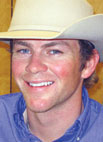
We've all been there. Trying to get some recalcitrant cow back to the barn.
Several torn fences and a few choice words later, we usually manage to complete the appointed task.
Well, Clayton Rains of Stockton, Mo., has a solution for us farmers who occasionally need to catch and move a sick or injured cow, calf or bull.
“I pretty well grew up my whole life in agriculture on a 200-acre beef farm in Stockton,” said the 25-year-old Clayton. “One year we finally got a good front-end loader tractor. I always thought they were one of the handiest pieces of machinery on the farm.”
It was only natural for this young man to turn to this farm implement and begin sketching out a design for an even better implement.
“Every time we had a cow that got sick, she was too far away from the barn. So we’d rope them and tie them to a tree.”
Clayton began working on his idea in 2005. “I did all my ground-work and research, and then I went to my grandma and asked if I could borrow some money to develop my idea.”
Four years later, that original $2,000 loan is paid off, and Clayton has finished and sold three of his invention. A fourth has been built. A patent is underway and should be completed in two to three years, but his work is already protected.
His invention? In patent-eze it’s an Aerial Catch and Capture by Land Vehicle. It translates to what Clayton calls the “Mobile Livestock Clinic.”
The 1,200-pound clinic is constructed of welded steel – “No bolts,” per Clayton. The device is an eight by eight-foot pen that can attach to a front-end loader. The pen is raised up. The farmer drives his tractor near the injured or sick cow.
Clayton thinks most cows are “already conditioned and less apt to run from a tractor if they are fed with it everyday. But if a cow hasn’t seen a tractor in a month, this isn’t going to work.” Tractors can go most anywhere on the farm that a truck and a trailer might not.
The bottomless (for now) mobile livestock clinic is set down over and around the cow. A two foot wide floor folds out, the farmer swings the gate around and the cow is moved into a head-gate and secured. At this point the cow is standing on a floor.
Once secured, several options are open to the farmer. The mobile clinic can be lifted and the tractor driven back to the barn or to a flatbed where it can be reloaded if the cow must be carried off the farm. The mobile clinic can be used for on-site doctoring and working cattle in conjunction with an alley and a pen if necessary.
The mobile clinic is sturdy enough to leave in the field. Clayton described another benefit, “I like that you can catch the cow, call the vet, leave her in the mobile clinic and tell the vet where she is.”
Clayton said he has had a 2,000-pound bull in one and wasn’t worried. “He might drag that thing around a little bit.” But no harm done.
Clayton’s first sale of a mobile clinic was to a feedlot owner in Ft. Scott, Kan. For now brochures and demonstration DVDs are the primary marketing tools, but he expects to be at Farm Fest in October. He also plans to have mobilelivestockclinic.com up soon. For now, Clayton will continue working in sales at S&H in Lockwood, Mo.
Clayton is going slow, he said. “I’m building relationships with farmers. They’ll tell you what is wrong (with his equipment) and how you can improve. So I go slow and get good feedback.” He has made small changes on latches and the thickness of the floor metal, but the patenting process requires that any changes be small.
“I started with no money and a few drawings on paper," he smiled. "I’m excited at how far I’ve come."







